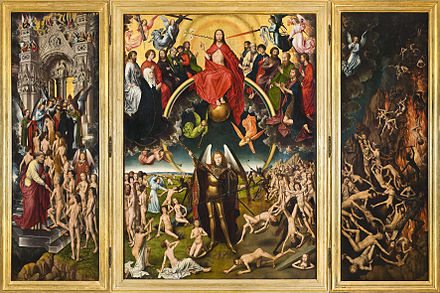The Last Judgment (Hans Memling)

The Last Judgment , also a triptych of the Last Judgment , is a triptych by Hans Memling . The subject is taken from the Revelation of the Evangelist John .
It depicts the judge of the world on the day of judgment , the resurrection of the dead on the last day , the weighing of souls by the archangel Michael and the entry of the saved into heavenly Jerusalem ( paradise ) as well as the walk of the damned into hell . Probably only the two portraits of the donors could be seen on weekdays ; the two wings were only opened on Sundays and public holidays, revealing the three central panels.
Data
The central panel of the altarpiece painted with oil and tempera on wood is 242 × 180 cm, the two wings each measure 242 × 90 cm. The painting was probably made between 1467 and 1471. The original is in the National Museum in Gdansk and a copy in the St. Mary's Church in Gdansk.
description
On the middle panel you can see Jesus as the judge of the world, sitting on a rainbow ( Rev 4,3 EU ). Lily and sword are to the left and right of his mouth, marking the sides of the redeemed and the damned. Mary kneels on his left side and John the Baptist on his right side with a red-lined black cloak over his fur robe. The twelve apostles are arranged in a semicircle . Under Jesus the Archangel Michael , armed in a harness , as a soul weigher . The fate of the damned is depicted on the right panel. Seized by devils , they are drawn to hell . On the left is the admission of the blessed into paradise ( heavenly Jerusalem ); they are greeted by Peter and then dressed again.
On the back of the two wings, the archangel Michael fighting a lindworm (devil) lying on the ground and a crowned Madonna with the baby Jesus is depicted. Both figures stand on pedestals and are made using the grisaille technique. In the lower zone of the two side wings, the donor couple in black and red , Angelo di Jacopo Tani , representative of the Medici banking house in Bruges , and his wife Caterina di Franceso Tangeli , each with their coats of arms.
The way to Gdansk
The triptych was commissioned by Angelo di Jacopo Tani (1415–1482) in Bruges around 1467 for the Michael Chapel of Badia Fiesolana , which had been donated by the Medici in Fiesole . Tani was managing director of the Medici Bank in Bruges from 1455 to 1460. The ship, with which the picture was to be brought to Florence in 1473 , was captured by the Peter von Danzig , a ship of the Hanseatic League , shortly after it left the port. Part of the prize , including the painting, was brought to Gdansk. It was given to St. Mary's Church by Reinhold Niederhoff, the then mayor of Gdansk, although the rightful Florentine owner, Tommaso Portinari , tried to return it. Despite the intervention of Charles the Bold , then Duke of Burgundy , and Pope Sixtus IV , the booty was kept in Danzig. However, the city of Bruges paid compensation to Tommaso Portinari.
See also
literature
- Dirk de Vos: Hans Memling. The complete work . Stuttgart / Zurich 1994, ISBN 3-7630-2312-7
- Dirk de Vos: Flemish Masters: Jan van Eyck, Rogier van der Weyden, Hans Memling. DuMont, Cologne, ISBN 3-8321-7201-7
- Karl Schütz: The Danzig world court altar by Hans Memling . In: Museum Association. Vienna 2002. pp. 13-18 pdf
Web links
Individual evidence
- ↑ A well-founded assumption about the painter of this copy can be found in the blog A copy by Hans Memling "The Last Judgment" and its fate
- ↑ Karl Schütz. 2002. p. 15.

